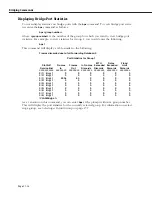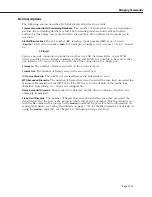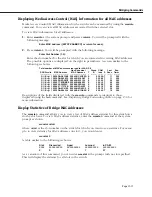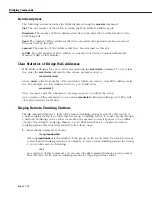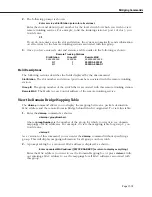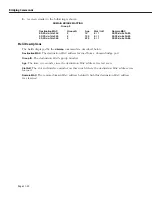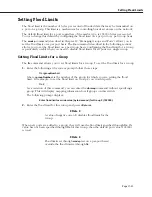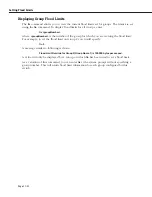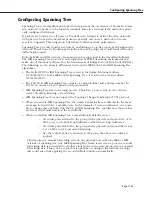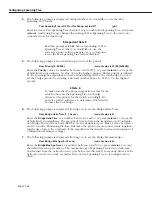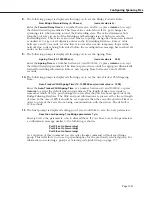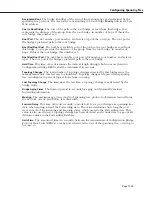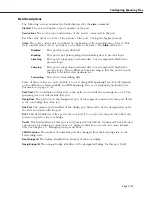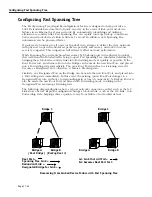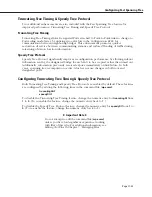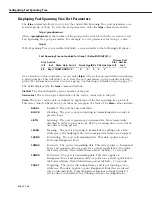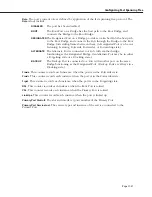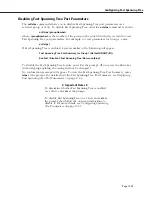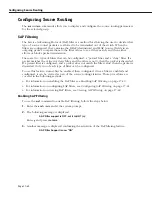
Configuring Spanning Tree
Page 17-28
Display Spanning Tree Bridge Parameters
The
sts
command allows you to display spanning tree bridge parameters. To display
spanning tree parameters, enter the
sts
command as shown:
sts <groupNumber>
where
<groupNumber>
is the number of the group in the switch for which you want to view
spanning tree bridge parameters. For example, to view parameters for Group 2, you would
enter:
sts 2
A screen similar to the following is displayed:
Spanning Tree Parameters for Group 2 (New GROUP (#2))
Spanning Tree Status
:
ON
Fast Spanning Tree Status:
OFF
Bridge Protocol Use
:
IEE E 802.1D
Priority
:
32768 (0x8000)
Bridge ID
:
8000-0020DA:022860
Designated Root
:
8000-0020DA:022860
Cost to Root Bridge
:
0
Root Port
:
None
Next Best Root Cost
:
0
Next Best Root Port
:
None
Hold Time
:
1
Topology Changes
:
1
Last Topology Change
:
1 hours, 25 minutes, 54 seconds ago
Bridge Aging Timer
:
300
Parameters system uses when
Current Parameters
attempt to become root
---------------------------------------------------------
-----------------------------------------------------
Max Age
20 secs
System Max Age
20 secs
Forward Delay
15 sec
System Forward Delay
15 secs
Hello Time
2 secs
System Hello Time
2 secs
As a variation of this command, you can enter
sts
at the system prompt without specifying a
group. This will display bridge parameters for the currently selected group. For information
on selecting a group, see
Selecting a Default Group
on page 17-7.
Field Descriptions
The following sections describe the fields displayed using the
sts
command.
Spanning Tree Status
. Spanning tree is either
ON
or
OFF
.
Fast Spanning Tree Status
. Fast spanning tree is either
ON
or
OFF
.
Bridge Protocol Used.
The bridge spanning tree protocol is set up through the
stc
command.
This protocol can be IEEE 802.1D or IBM Spanning Tree. The type of spanning tree protocol
used will affect other bridge parameters, such as
Maximum Age
,
Forwarding Delay
, and
Hello
Time
. See
Configuring Spanning Tree Parameters
on page 17-25 for more information on the
differences between IEEE and IBM Spanning Tree.
Priority.
Bridge priority is utilized by the spanning tree algorithm to decide which bridge will
be the root bridge. You can set the bridge priority by entering a decimal number from 0 to
65,535. Zero is the highest priority.
Bridge ID.
The bridge identification number is a number created by concatenating the bridge
Priority
with its six-byte MAC address.
Summary of Contents for Omni Switch/Router
Page 1: ...Part No 060166 10 Rev C March 2005 Omni Switch Router User Manual Release 4 5 www alcatel com ...
Page 4: ...page iv ...
Page 110: ...WAN Modules Page 3 40 ...
Page 156: ...UI Table Filtering Using Search and Filter Commands Page 4 46 ...
Page 164: ...Using ZMODEM Page 5 8 ...
Page 186: ...Displaying and Setting the Swap State Page 6 22 ...
Page 202: ...Creating a New File System Page 7 16 ...
Page 270: ...Displaying Secure Access Entries in the MPM Log Page 10 14 ...
Page 430: ...OmniChannel Page 15 16 ...
Page 496: ...Configuring Source Route to Transparent Bridging Page 17 48 ...
Page 542: ...Dissimilar LAN Switching Capabilities Page 18 46 ...
Page 646: ...Application Example DHCP Policies Page 20 30 ...
Page 660: ...GMAP Page 21 14 ...
Page 710: ...Viewing the Virtual Interface of Multicast VLANs Page 23 16 ...
Page 722: ...Application Example 5 Page 24 12 ...
Page 788: ...Viewing UDP Relay Statistics Page 26 24 ...
Page 872: ...The WAN Port Software Menu Page 28 46 ...
Page 960: ...Deleting a PPP Entity Page 30 22 ...
Page 978: ...Displaying Link Status Page 31 18 ...
Page 988: ...Displaying ISDN Configuration Entry Status Page 32 10 ...
Page 1024: ...Backup Services Commands Page 34 14 ...
Page 1062: ...Diagnostic Test Cable Schematics Page 36 24 ...
Page 1072: ...Configuring a Switch with an MPX Page A 10 ...
Page 1086: ...Page B 14 ...
Page 1100: ...Page I 14 Index ...

